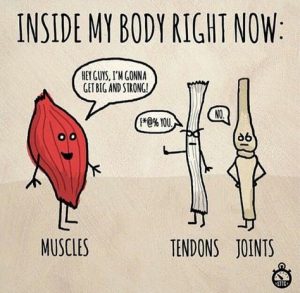Rehab and PT
 I’m still dealing with the fallout of the my injuries unfortunately. It’s been 3 weeks since I’ve really run any distance. This is more than mildy depressing due to the our upcoming 50K and 50M races we’ve already planned out, paid for and been training for.
I’m still dealing with the fallout of the my injuries unfortunately. It’s been 3 weeks since I’ve really run any distance. This is more than mildy depressing due to the our upcoming 50K and 50M races we’ve already planned out, paid for and been training for.
I went to my GP who bascially said, “Beats me what’s wrong.” and prescribed Naprosyn aka Naproxim aka Alleve as an anti-inflammatory. He did get me a referring to a sports injury specialist who was also “Beats me what’s wrong”. I have so little faith in our medical industry and based on personal experience justifiably so. WebMD has proven to be as valid if not more so in my findings. I won’t go into my medical history but trust me, my opinion is justified based on my interactions with the doctors I’ve had over the last 20 years. Anyway bottom line is X-Rays didn’t show any stress fractures of the bones which barring a more detailed analysis using MRI or something called a bone scan (might be the same thing) indicates the problem is stressed and inflamed nerves and tendons/ligaments and irritated end caps on the bones. This translates to metatarsalgia and Morton’s Neuroma. The cure? Stop doing whatever it was that caused it.
But my ability to go long is taking the hit I’m sure.
In the last 2 weeks I’ve been doing various low impact sports, indoor bike, two types of elliptical both with inclines, water jogging and various weight machines for upper and lower body strength training. One thing I’m finding is training for an ultra gives you the ability to ignore the passage of time to some degree. You can do something incredibly boring like pedaling a ‘bike’ indoors for an hour without much mental effort.
One of the oddities is I’m having a very hard time cranking my HR up due to lack of musculature development for these particular exercises. My muscles give out before my cardio system starts to get taxed. An hour of bike at level 12? 100 BPM but quads are tore up. Followed by an hour of inclined elliptical at level 15? 105 BPM with quads, hams, calves hurting. Not remotely close to breathing hard. An hour+ of aqua jogging? 98bpm but calves cramping up.
It’s getting better in terms of I’m seeing fairly rapid capacity in my ability to bike and elliptical for longer times, it’s just different muscles than I use for running or rather they’re used in different ways, just enough to be pretty interesting from a science/technical perspective.
I feel I am improving my ability to go vertical, my quads especially are feeling the heat with that background burn that indicates you’re tearing down and building muscle fibers. But my ability to go long is taking the hit I’m sure.
Another interesting factoid is how quickly my resting heart rate started climbing up. It’s 3 beats higher now than it was pre-injury. How quickly we start to lose our capacity is just interesting to me in a morbid kind of way.
This weekend I’m going to do some Carls, at least 2 or 3 hours if I can. On Sunday I’m going to run some easy trails and try out my new shoes, Sketchers GoRun MaxTrail 5. Sketchers?! WTF?! Well a fair number of runners say these are sleeper shoes and are far better than one might think considering the brand. Sketchers apparently has upped their game in the last couple of years and their shoes are getting pretty good. Allegedly.
As I’m desperate to find shoes that I like with the demise of my Lone Peak 3.5’s I’m willing to take a chance on them. And if they don’t work out then back they go.
I tried the Hoka Bondi 5’s given their ridoculous stack height which I hoped would equate to more protection for the damaged feet and frankly there wasn’t anything about them that I liked. Nothing I disliked but nothing I liked. And they left pain points on my arches toward the heel side just walking around on them. They weren’t very ‘cushy’ feeling either given their stack height. Almost like a brick in comparison to the Hoka’s I tried on back in early 2016.
I have a pair of Hoka Napali’s waiting for a shot as well as so many people seem to think they’re a throwback to the Clifton 3’s. Frankly just standing in them I don’t feel it but I’ll withhold judgement till I can get them out on the street.
With less than a month till our first 50K I’m not really feeling that great about it. 🙁